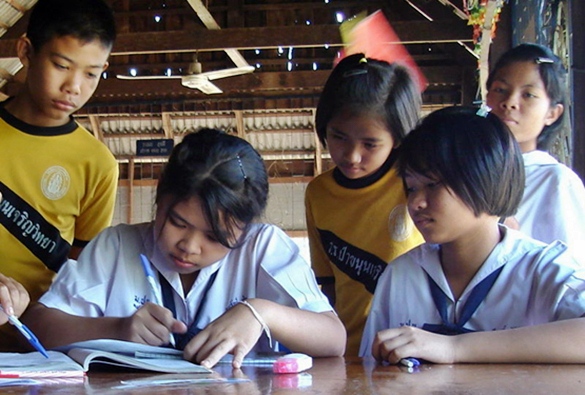What is the Average Class Size if Teaching English in Thailand?
As a former English teacher in Thailand, one of the things I always checked before I accepted a new teaching job was the average class size at the school. Class size in Thailand is a contentious issue for foreign teachers all over the country as every teacher knows, if you are stuck with a class of 50-plus children, teaching most of them anything becomes a huge chore and is detrimental to both the children and to you.
Average class sizes in Thailand vary greatly depending on if the school you are teaching at is a private school or a government school, or a private language school. You may end up teaching a class of only a handful of students, or one of 50 or more.
Normally though, here is what you can expect for class sizes at most typical Thai schools. Just remember to check specifics before you accept a teaching job.
Thai government schools – Thai government schools not only offer some of the lowest paying teaching jobs in Thailand, their average class sizes are also notoriously huge with at least 45-50 students in each class. Even the top government schools that every parent is clamoring to get their children accepted into may have enormous classes.
A recent Bangkok Post article discussed the issue of overcrowded classrooms in Thailand and stressed that class sizes at every school should be limited to 35 students. To a western teacher coming from a background where 20-25 students is the norm, 35 students seems too many.
Imagine what it’s like then trying to teach 55-60 children all in one classroom, and maintain discipline while you do. Impossible hardly covers it.
While you may not have a choice when it comes to class sizes of 50 students or more at any Thai government school, you do have a choice as to whether you accept the job or not. Unless it’s an absolute last resort to you, I’d recommend you don’t as teaching classes of more than 50 students is stressful beyond belief.
Thai private schools – Private schools in Thailand are often much better at handling their class sizes, as parents are paying expensive fees and not willing to pay them if their child is then going to be taught in a classroom with 44 other students.
I taught at a private bi-lingual school in Thailand for three years where my smallest class size was just 12 students and my largest one had 28. While the 28 students were obviously more difficult to control than the smaller group, as Thai students notoriously lack discipline, it was still an easily manageable number.
At most Thai private schools, you can expect anything from 15 students in a class up to around 30. Any more and it’s more than likely that the private school is not a particularly prestigious one, or is trying to gouge parents for fees while short-changing their children in the education they’re getting.
One of my closest friends taught at one of the cheaper private school chains in Bangkok and still had to struggle with classes of upwards of 40 students. Needless to say, she only lasted a semester before she moved to a better private school with lower class numbers.
Be sure to ask about average class size at any private school in Bangkok and avoid those with 30 students or more. Unsurprisingly, these schools are not only short changing their students, but the salaries they pay their teachers are often some of the lowest around as well.

Universities in Thailand – Teaching at a university in Thailand does not mean you will suddenly be offered small class sizes. In fact, you may be surprised at how many students some Thai universities manage to cram into their classrooms.
Chulalongkorn University, the top university in Thailand, often has 70-plus students in a classroom and Ramkhamhaeng University, an open university in Bangkok, is known for its classes of 100 students or more. Ramkhamhaeng will accept just about anyone that applies in most faculties, with the result they have more than 430,000 students at any one time and are now one of the 10 largest universities in the world.
If you want to teach at a Thai university, be sure to find out about class sizes and whether you will be teaching in their regular program or their international program. International programs tend to have much stricter admission policies, so classroom sizes are markedly smaller.
Language schools in Thailand – The vast majority of language schools in Thailand have small classes as, again, fees are being paid and students and parents are not likely to pay high fees to sit in a classroom with 40 other people.
In most language schools in Thailand, you can expect anything from one-on-one teaching to small groups of three to eight students. I’ve worked at two language schools during my 12 years living in Thailand, although that work was teaching business English at local Thai companies. I’ve never had more than 18 students in a class, and typically it was more like 12 or under.
If you prefer to teach small classes or like teaching one-on-one, language schools can definitely be your best option.

